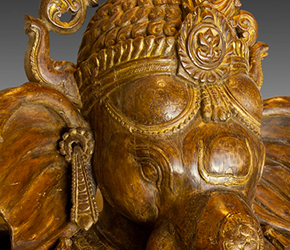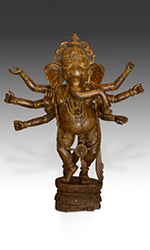| |
 |
| |
A large standing figure of Ganesh carved in wood (detail) |
Ganesh
surfaced as a distinct deity around the 4th or 5th century C.E. during the Gupta period, and was likely inspired by vedic and pre-vedic mythology. He has been depicted with the head of an elephant and the body of a human since ancient times, and there are many narrative explanations for this. One is that he was simply born this way, another tells that as baby his head was incinerated by the evil eye of the Goddess Shani, and when Vishnu discovered this, he took piety and replaced the baby’s head with an elephant’s.
 |
|
| A large tantric standing figure of Ganesh |
|
Of all
Hindu
deities, Ganesh, is one of the most revered. Ganesh has many roles – God of wisdom, commerce, and all the creative arts and sciences – but perhaps the most important is as “the remover of obstacles.” To worship Ganesh is to harness the energy of communication and opportunity, a world where anything and everything is possible. Ganesh is also a highly protective deity, for just as easily as Ganesh can remove obstacles from someone’s path, Ganesh can place obstacles there as well. In this regard, Ganesh protects individuals by blocking harm, illness and misfortune.
In Hinduism, each deity has a “mount,” an animal or demi-god associated with the deity and attributed with special powers. The mount of Ganesh is a rat or mouse. Conceptually, the mouse can go into cracks and crevices, places where humans cannot go, to remove obstacles. The worship of Ganesh almost always preceded the propitiation of any other deity as it was believed only Ganesh could open the door to successful worship. He is one of the few deities that is venerated by not only Hindus, but also Jains,
Buddhists, and Vedics.
Ganesh’s affinity for sweets, candy, and sugarcane are representative of his accessibility to the common man, and his general good nature.
Download this Article: Ganesh.pdf

